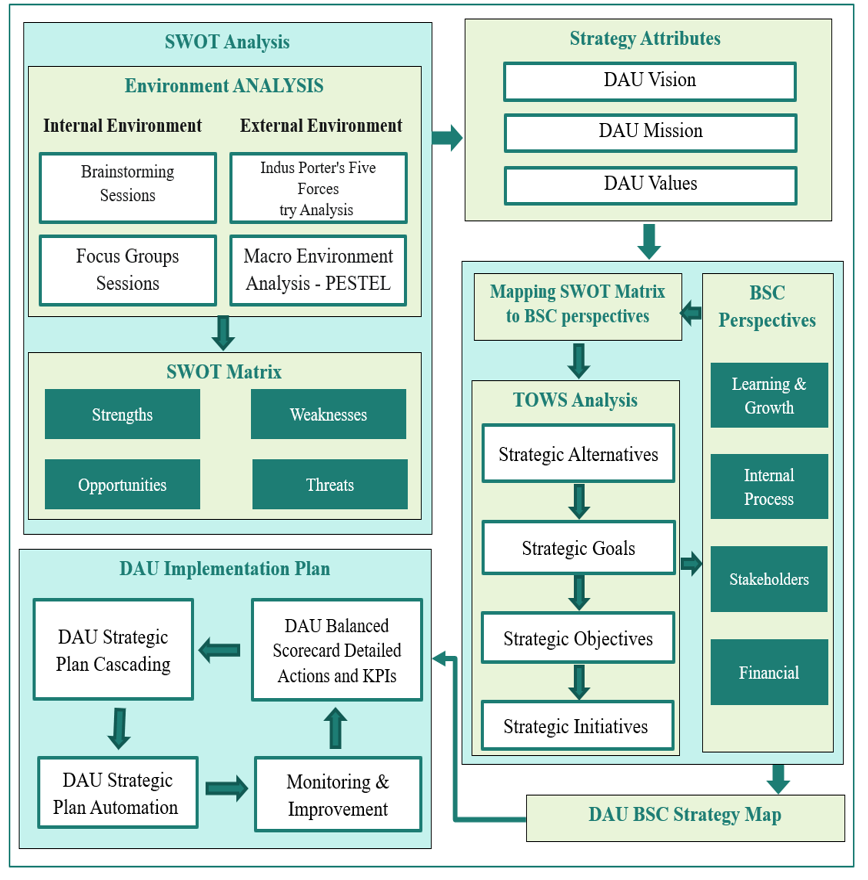Strategic Planning Methodology
Strategic Plan Structuring:
DAU’s second strategic plan (2023-2027) was developed using a variety of strategic analysis tools. The SWOT analysis identifies and analyses internal strengths and weaknesses as well as external opportunities and threats. To identify strengths and weaknesses, we conducted many brainstorming sessions and focus groups with internal and external stakeholders. To identify opportunities and threats, we rely on Porter’s Five Forces framework, which identifies and analyses the five competitive forces shaping the private higher education industry in Riyadh, and on the PESTEL framework for analyzing macro-environmental factors affecting the industry holistically.
The SWOT analysis, however, provides no guidance, prioritizes issues, or suggests strategic alternatives because it only provides a snapshot of a firm at a particular moment in time. Taking a SWOT analysis, a step further, we created the TOWS Matrix, which offers an advanced analysis that generates possible strategic alternatives by matching internal strengths and weaknesses with external opportunities and threats.
The strategic planning methodology adopted is the Balanced Scorecard (BSC) framework developed by Robert Kaplan and David Norton (1992). BSC is a strategic planning and management framework that helps organizations translate their vision and strategy into action. It does this by providing a framework for defining, monitoring, and managing performance objectives in four perspectives: financial, stakeholders, internal processes, and learning and growth.
–
The figure below shows the structure of developing DAU’s Second Strategic Plan (2023-2027):
–
The BSC Framework:
The BSC framework is widely used in large companies, as well as many reputable universities, as a strategic planning framework. Instead of focusing solely on operational performance and financial indicators, this framework links strategic performance to measurable goals and objectives in four perspectives. The four perspectives of the balanced scorecard framework in our second strategic plan are as follows:
- Learning and Growth Perspective: According to this perspective, the university’s objectives and measures aim to close a gap between current human capital, informational capital, and organizational capital, on the one hand, and the environment needed to maintain success, on the other, and to ensure sustainable performance in the future.
- Internal Process Perspective: The objectives and measures in this perspective are meant to identify the key processes that university must excel at to continue adding value to students and ultimately shareholders. These processes include learning, research, community engagement, partnerships, and management.
- Stakeholder Perspective: The objectives and measures in this perspective focus on maximizing the value proposition of the costumer, through improving stakeholders’ satisfaction, loyalty, and perception of the university in terms of its ability to provide enriching learning experiences to its students.
- Financial Perspective: Through the objectives and measures in this perspective, the university aims to ensure that by meeting the objectives and measures chosen in the other three perspectives, its financial performance will be positively impacted by growth prospects, improved asset utilization, and cost-savings.
–
Advantages of adopting the BSC framework:
Several aspects of the strategic planning process at the university are expected to be positively impacted by our adoption of the balanced scorecard framework in our second strategic plan, most notably:
- BSC allows DAU’s performance improvement strategies to be mapped and links to multiple organizational levels.
- The framework identifies cause-and-effect relationships among the four perspectives of the Balanced Scorecard.
- The strategy map component of the BSC provides a graphical description of DAU’s strategy, including the interrelationships of its elements. This map is considered the blueprint for the organizational plan.
- The BSC’s cascading process gives DAU a tool for taking the scorecard down to departmental, unit, divisional, or individual measures of performance, resulting in a consistent focus at all organizational levels. From DAU’s BSC, there will be a BSC for each unit, containing the same goals, initiatives, and performance indicators adapted to fit the unit’s responsibilities. Therefore, balancing will not only take place at the level of the four perspectives, but also at the organizational level.
- The cascading of the scorecard also presents DAU’s faculties and staff with a clear image of how their individual actions make a difference in relation to DAU’s strategic objectives. The cascaded scorecard creates alignment among the performance measurement outcomes throughout the various organizational levels.
- The BSC is a powerful communications tool across all DAU levels.
- Automation of the balanced scorecard is a valuable tool for monitoring performance metrics and implementing strategies to achieve strategic objectives. Our strategy map, performance measures, and related initiatives are all accessible through the dashboard.

 College of Medicine
College of Medicine College of Dentistry
College of Dentistry College of Architectural Eng & Digital Design
College of Architectural Eng & Digital Design College of Business Administration
College of Business Administration College of Law
College of Law University Preparatory Program
University Preparatory Program College of Pharmacy and Applied Medical Sciences
College of Pharmacy and Applied Medical Sciences Student Affairs Department
Student Affairs Department General Directorate of Planning, Development, and Quality Assurance
General Directorate of Planning, Development, and Quality Assurance